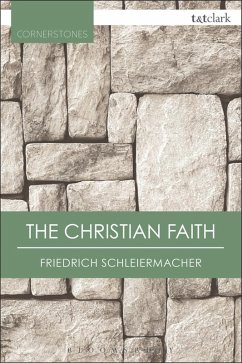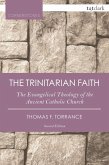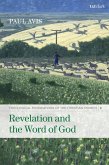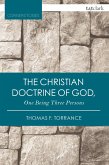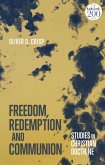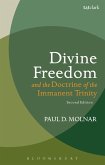Friedrich Schleiermacher
The Christian Faith (eBook, ePUB)
43,95 €
43,95 €
inkl. MwSt.
Sofort per Download lieferbar

22 °P sammeln
43,95 €
Als Download kaufen

43,95 €
inkl. MwSt.
Sofort per Download lieferbar

22 °P sammeln
Jetzt verschenken
Alle Infos zum eBook verschenken
43,95 €
inkl. MwSt.
Sofort per Download lieferbar
Alle Infos zum eBook verschenken

22 °P sammeln
Friedrich Schleiermacher
The Christian Faith (eBook, ePUB)
- Format: ePub
- Merkliste
- Auf die Merkliste
- Bewerten Bewerten
- Teilen
- Produkt teilen
- Produkterinnerung
- Produkterinnerung

Bitte loggen Sie sich zunächst in Ihr Kundenkonto ein oder registrieren Sie sich bei
bücher.de, um das eBook-Abo tolino select nutzen zu können.
Hier können Sie sich einloggen
Hier können Sie sich einloggen
Sie sind bereits eingeloggt. Klicken Sie auf 2. tolino select Abo, um fortzufahren.

Bitte loggen Sie sich zunächst in Ihr Kundenkonto ein oder registrieren Sie sich bei bücher.de, um das eBook-Abo tolino select nutzen zu können.
Known as the father of modern theology, Schleiermacher was equally at home in the theological systems of Protestant orthodoxy and the new world of thought shaped by the historical and natural sciences and German philosophy. This ease in different theological frameworks is clearly shown in his discussion of the wide range of themes in dogmatics.
This volume outlines Schleiermacher's views on every major doctrine of orthodox Christianity. This classic work in systematic theology remains an indispensable volume to any student of theology, and especially for those who want to understand liberal…mehr
- Geräte: eReader
- mit Kopierschutz
- eBook Hilfe
- Größe: 0.85MB
Andere Kunden interessierten sich auch für
![The Trinitarian Faith (eBook, ePUB) The Trinitarian Faith (eBook, ePUB)]() Thomas F. TorranceThe Trinitarian Faith (eBook, ePUB)23,95 €
Thomas F. TorranceThe Trinitarian Faith (eBook, ePUB)23,95 €![Revelation and the Word of God (eBook, ePUB) Revelation and the Word of God (eBook, ePUB)]() Paul AvisRevelation and the Word of God (eBook, ePUB)25,95 €
Paul AvisRevelation and the Word of God (eBook, ePUB)25,95 €![The Christian Doctrine of God, One Being Three Persons (eBook, ePUB) The Christian Doctrine of God, One Being Three Persons (eBook, ePUB)]() Thomas F. TorranceThe Christian Doctrine of God, One Being Three Persons (eBook, ePUB)23,95 €
Thomas F. TorranceThe Christian Doctrine of God, One Being Three Persons (eBook, ePUB)23,95 €![Freedom, Redemption and Communion: Studies in Christian Doctrine (eBook, ePUB) Freedom, Redemption and Communion: Studies in Christian Doctrine (eBook, ePUB)]() Oliver D. CrispFreedom, Redemption and Communion: Studies in Christian Doctrine (eBook, ePUB)23,95 €
Oliver D. CrispFreedom, Redemption and Communion: Studies in Christian Doctrine (eBook, ePUB)23,95 €![Divine Freedom and the Doctrine of the Immanent Trinity (eBook, ePUB) Divine Freedom and the Doctrine of the Immanent Trinity (eBook, ePUB)]() Paul D. MolnarDivine Freedom and the Doctrine of the Immanent Trinity (eBook, ePUB)34,95 €
Paul D. MolnarDivine Freedom and the Doctrine of the Immanent Trinity (eBook, ePUB)34,95 €![T&T Clark Reader in Edward Schillebeeckx (eBook, ePUB) T&T Clark Reader in Edward Schillebeeckx (eBook, ePUB)]() T&T Clark Reader in Edward Schillebeeckx (eBook, ePUB)22,95 €
T&T Clark Reader in Edward Schillebeeckx (eBook, ePUB)22,95 €![Reasons to Hope (eBook, ePUB) Reasons to Hope (eBook, ePUB)]() Werner G. JeanrondReasons to Hope (eBook, ePUB)22,95 €
Werner G. JeanrondReasons to Hope (eBook, ePUB)22,95 €-
-
-
Known as the father of modern theology, Schleiermacher was equally at home in the theological systems of Protestant orthodoxy and the new world of thought shaped by the historical and natural sciences and German philosophy. This ease in different theological frameworks is clearly shown in his discussion of the wide range of themes in dogmatics.
This volume outlines Schleiermacher's views on every major doctrine of orthodox Christianity. This classic work in systematic theology remains an indispensable volume to any student of theology, and especially for those who want to understand liberal theology. This Cornerstones edition has a new preface written by Professor Paul T. Nimmo, a well-known expert on Schleiermacher and his contribution to theology.
This volume outlines Schleiermacher's views on every major doctrine of orthodox Christianity. This classic work in systematic theology remains an indispensable volume to any student of theology, and especially for those who want to understand liberal theology. This Cornerstones edition has a new preface written by Professor Paul T. Nimmo, a well-known expert on Schleiermacher and his contribution to theology.
Produktdetails
- Produktdetails
- Verlag: Bloomsbury UK eBooks
- Seitenzahl: 800
- Erscheinungstermin: 25. August 2016
- Englisch
- ISBN-13: 9780567658869
- Artikelnr.: 45557491
- Verlag: Bloomsbury UK eBooks
- Seitenzahl: 800
- Erscheinungstermin: 25. August 2016
- Englisch
- ISBN-13: 9780567658869
- Artikelnr.: 45557491
- Herstellerkennzeichnung Die Herstellerinformationen sind derzeit nicht verfügbar.
Friedrich Schleiermacher (1786-1834) was a German theologian, philosopher, and biblical scholar known for his attempt to reconcile the criticisms of the Enlightenment with traditional Protestant Christianity.
Paul T. Nimmo is Professor of Systematic Theology at the University of Aberdeen, UK.
Paul T. Nimmo is Professor of Systematic Theology at the University of Aberdeen, UK.
New preface by Paul T. Nimmo
Introduction
Ch.1: The Definition of Dogmatics
1. The Conception of the Church
2. The Diversities of Religious Communions in General
3. Presentation of Christianity in its Peculiar Essence
4. The Relation of Dogmatics to Christian Piety
Ch.2: The Method of Dogmatics
1. The Selection of the Dogmatic Material
2. The Formation of the Dogmatic System
First part of the System of Doctrine:
First Section
1. Introduction
2. First Doctrine: Creation
3. First Appendix: The Angels
4. Second Appendix: The Devil
5. Second Doctrine: Preservation
Second Section
1. Introduction
2. First Doctrine: God is Eternal
3. Second Doctrine: God is Omnipresent
4. Third Doctrine: God is Omnipotent
5. Fourth Doctrine: God is Omniscient
6. Appendix: Some other Divine Attributes
Third Section
1. Introduction
2. First Doctrine: The Original Perfection of the World
3. Second Doctrine: The Original Perfection of Man
Second Part of the System of Doctrine
1. Introduction
First Aspect of the Antithesis: Explication of the Consciousness of Sin
First Section: Sin as a State of Man
1. First Doctrine: Original Sin
2. Second Doctrine: Actual Sin
Second Section: The Constitution of the World in Relation to Sin
Third Section: The Divine Attributes which relate to the Consciousness of
Sin
1. Introduction
2. First Doctrine: God is Holy
3. Second Doctrine: God is Just
4. Appendix: The Mercy of God
Second Aspect of the Antithesis: Explication of the Consciousness of Grace
1. Introduction
First Section: The State of the Christian as Conscious of the Divine Grace
First Division: Christ
1. Introduction
2. First Doctrine: The Person of Christ
3. Second Doctrine: The Work of Christ
Second Division: The Manner in which Fellowship with the Perfection and
Blessedness of the Redeemer expresses itself in the Individual Soul
1. Introduction
2. First Doctrine: Regeneration
3. Second Doctrine: Sanctification
Second Section: The Constitution of the World in relation to Redemption
1. Introduction
First Division: The Origin of the Church
1. Introduction
2. First Doctrine: Election
3. Second Doctrine: The Communication of the Holy Spirit
Second Division: The Subsistence of the Church alongside of the World
1. Introduction
First Half: The Essential and Invariable Features of the Church
1. Introduction
2. First Doctrine: Holy Scripture
3. Second Doctrine: The Ministry of the Word of God
4. Third Doctrine: Baptism
5. Fourth Doctrine: The Lord's Supper
6. Fifth Doctrine: The Power of the Keys
7. Sixth Doctrine: Prayer in the Name of Christ
Second Half: The Mutable Element Characteristic of the Church in Virtue of
its Coexistence with the World
1. Introduction
2. First Doctrine: The Plurality of the Visible Churches in Relation to the
Unity of the Visible
3. Second Doctrine: The Fallibility of the Visible Church in Relation to
the Infallibility of the Invisible
Third Division: The Consummation of the Church
1. Introduction
2. First Prophetic Doctrine: The Return of Christ
3. Second Prophetic Doctrine: The Resurrection of the Flesh
4. Third Prophetic Doctrine: The Last Judgment
5. Fourth Prophetic Doctrine: Eternal Blessedness
6. Appendix: On Eternal Damnation
Third Section: The Divine Attributes which relate to Redemption
Conclusion: The Divine Trinity
Indexes
Introduction
Ch.1: The Definition of Dogmatics
1. The Conception of the Church
2. The Diversities of Religious Communions in General
3. Presentation of Christianity in its Peculiar Essence
4. The Relation of Dogmatics to Christian Piety
Ch.2: The Method of Dogmatics
1. The Selection of the Dogmatic Material
2. The Formation of the Dogmatic System
First part of the System of Doctrine:
First Section
1. Introduction
2. First Doctrine: Creation
3. First Appendix: The Angels
4. Second Appendix: The Devil
5. Second Doctrine: Preservation
Second Section
1. Introduction
2. First Doctrine: God is Eternal
3. Second Doctrine: God is Omnipresent
4. Third Doctrine: God is Omnipotent
5. Fourth Doctrine: God is Omniscient
6. Appendix: Some other Divine Attributes
Third Section
1. Introduction
2. First Doctrine: The Original Perfection of the World
3. Second Doctrine: The Original Perfection of Man
Second Part of the System of Doctrine
1. Introduction
First Aspect of the Antithesis: Explication of the Consciousness of Sin
First Section: Sin as a State of Man
1. First Doctrine: Original Sin
2. Second Doctrine: Actual Sin
Second Section: The Constitution of the World in Relation to Sin
Third Section: The Divine Attributes which relate to the Consciousness of
Sin
1. Introduction
2. First Doctrine: God is Holy
3. Second Doctrine: God is Just
4. Appendix: The Mercy of God
Second Aspect of the Antithesis: Explication of the Consciousness of Grace
1. Introduction
First Section: The State of the Christian as Conscious of the Divine Grace
First Division: Christ
1. Introduction
2. First Doctrine: The Person of Christ
3. Second Doctrine: The Work of Christ
Second Division: The Manner in which Fellowship with the Perfection and
Blessedness of the Redeemer expresses itself in the Individual Soul
1. Introduction
2. First Doctrine: Regeneration
3. Second Doctrine: Sanctification
Second Section: The Constitution of the World in relation to Redemption
1. Introduction
First Division: The Origin of the Church
1. Introduction
2. First Doctrine: Election
3. Second Doctrine: The Communication of the Holy Spirit
Second Division: The Subsistence of the Church alongside of the World
1. Introduction
First Half: The Essential and Invariable Features of the Church
1. Introduction
2. First Doctrine: Holy Scripture
3. Second Doctrine: The Ministry of the Word of God
4. Third Doctrine: Baptism
5. Fourth Doctrine: The Lord's Supper
6. Fifth Doctrine: The Power of the Keys
7. Sixth Doctrine: Prayer in the Name of Christ
Second Half: The Mutable Element Characteristic of the Church in Virtue of
its Coexistence with the World
1. Introduction
2. First Doctrine: The Plurality of the Visible Churches in Relation to the
Unity of the Visible
3. Second Doctrine: The Fallibility of the Visible Church in Relation to
the Infallibility of the Invisible
Third Division: The Consummation of the Church
1. Introduction
2. First Prophetic Doctrine: The Return of Christ
3. Second Prophetic Doctrine: The Resurrection of the Flesh
4. Third Prophetic Doctrine: The Last Judgment
5. Fourth Prophetic Doctrine: Eternal Blessedness
6. Appendix: On Eternal Damnation
Third Section: The Divine Attributes which relate to Redemption
Conclusion: The Divine Trinity
Indexes
New preface by Paul T. Nimmo
Introduction
Ch.1: The Definition of Dogmatics
1. The Conception of the Church
2. The Diversities of Religious Communions in General
3. Presentation of Christianity in its Peculiar Essence
4. The Relation of Dogmatics to Christian Piety
Ch.2: The Method of Dogmatics
1. The Selection of the Dogmatic Material
2. The Formation of the Dogmatic System
First part of the System of Doctrine:
First Section
1. Introduction
2. First Doctrine: Creation
3. First Appendix: The Angels
4. Second Appendix: The Devil
5. Second Doctrine: Preservation
Second Section
1. Introduction
2. First Doctrine: God is Eternal
3. Second Doctrine: God is Omnipresent
4. Third Doctrine: God is Omnipotent
5. Fourth Doctrine: God is Omniscient
6. Appendix: Some other Divine Attributes
Third Section
1. Introduction
2. First Doctrine: The Original Perfection of the World
3. Second Doctrine: The Original Perfection of Man
Second Part of the System of Doctrine
1. Introduction
First Aspect of the Antithesis: Explication of the Consciousness of Sin
First Section: Sin as a State of Man
1. First Doctrine: Original Sin
2. Second Doctrine: Actual Sin
Second Section: The Constitution of the World in Relation to Sin
Third Section: The Divine Attributes which relate to the Consciousness of
Sin
1. Introduction
2. First Doctrine: God is Holy
3. Second Doctrine: God is Just
4. Appendix: The Mercy of God
Second Aspect of the Antithesis: Explication of the Consciousness of Grace
1. Introduction
First Section: The State of the Christian as Conscious of the Divine Grace
First Division: Christ
1. Introduction
2. First Doctrine: The Person of Christ
3. Second Doctrine: The Work of Christ
Second Division: The Manner in which Fellowship with the Perfection and
Blessedness of the Redeemer expresses itself in the Individual Soul
1. Introduction
2. First Doctrine: Regeneration
3. Second Doctrine: Sanctification
Second Section: The Constitution of the World in relation to Redemption
1. Introduction
First Division: The Origin of the Church
1. Introduction
2. First Doctrine: Election
3. Second Doctrine: The Communication of the Holy Spirit
Second Division: The Subsistence of the Church alongside of the World
1. Introduction
First Half: The Essential and Invariable Features of the Church
1. Introduction
2. First Doctrine: Holy Scripture
3. Second Doctrine: The Ministry of the Word of God
4. Third Doctrine: Baptism
5. Fourth Doctrine: The Lord's Supper
6. Fifth Doctrine: The Power of the Keys
7. Sixth Doctrine: Prayer in the Name of Christ
Second Half: The Mutable Element Characteristic of the Church in Virtue of
its Coexistence with the World
1. Introduction
2. First Doctrine: The Plurality of the Visible Churches in Relation to the
Unity of the Visible
3. Second Doctrine: The Fallibility of the Visible Church in Relation to
the Infallibility of the Invisible
Third Division: The Consummation of the Church
1. Introduction
2. First Prophetic Doctrine: The Return of Christ
3. Second Prophetic Doctrine: The Resurrection of the Flesh
4. Third Prophetic Doctrine: The Last Judgment
5. Fourth Prophetic Doctrine: Eternal Blessedness
6. Appendix: On Eternal Damnation
Third Section: The Divine Attributes which relate to Redemption
Conclusion: The Divine Trinity
Indexes
Introduction
Ch.1: The Definition of Dogmatics
1. The Conception of the Church
2. The Diversities of Religious Communions in General
3. Presentation of Christianity in its Peculiar Essence
4. The Relation of Dogmatics to Christian Piety
Ch.2: The Method of Dogmatics
1. The Selection of the Dogmatic Material
2. The Formation of the Dogmatic System
First part of the System of Doctrine:
First Section
1. Introduction
2. First Doctrine: Creation
3. First Appendix: The Angels
4. Second Appendix: The Devil
5. Second Doctrine: Preservation
Second Section
1. Introduction
2. First Doctrine: God is Eternal
3. Second Doctrine: God is Omnipresent
4. Third Doctrine: God is Omnipotent
5. Fourth Doctrine: God is Omniscient
6. Appendix: Some other Divine Attributes
Third Section
1. Introduction
2. First Doctrine: The Original Perfection of the World
3. Second Doctrine: The Original Perfection of Man
Second Part of the System of Doctrine
1. Introduction
First Aspect of the Antithesis: Explication of the Consciousness of Sin
First Section: Sin as a State of Man
1. First Doctrine: Original Sin
2. Second Doctrine: Actual Sin
Second Section: The Constitution of the World in Relation to Sin
Third Section: The Divine Attributes which relate to the Consciousness of
Sin
1. Introduction
2. First Doctrine: God is Holy
3. Second Doctrine: God is Just
4. Appendix: The Mercy of God
Second Aspect of the Antithesis: Explication of the Consciousness of Grace
1. Introduction
First Section: The State of the Christian as Conscious of the Divine Grace
First Division: Christ
1. Introduction
2. First Doctrine: The Person of Christ
3. Second Doctrine: The Work of Christ
Second Division: The Manner in which Fellowship with the Perfection and
Blessedness of the Redeemer expresses itself in the Individual Soul
1. Introduction
2. First Doctrine: Regeneration
3. Second Doctrine: Sanctification
Second Section: The Constitution of the World in relation to Redemption
1. Introduction
First Division: The Origin of the Church
1. Introduction
2. First Doctrine: Election
3. Second Doctrine: The Communication of the Holy Spirit
Second Division: The Subsistence of the Church alongside of the World
1. Introduction
First Half: The Essential and Invariable Features of the Church
1. Introduction
2. First Doctrine: Holy Scripture
3. Second Doctrine: The Ministry of the Word of God
4. Third Doctrine: Baptism
5. Fourth Doctrine: The Lord's Supper
6. Fifth Doctrine: The Power of the Keys
7. Sixth Doctrine: Prayer in the Name of Christ
Second Half: The Mutable Element Characteristic of the Church in Virtue of
its Coexistence with the World
1. Introduction
2. First Doctrine: The Plurality of the Visible Churches in Relation to the
Unity of the Visible
3. Second Doctrine: The Fallibility of the Visible Church in Relation to
the Infallibility of the Invisible
Third Division: The Consummation of the Church
1. Introduction
2. First Prophetic Doctrine: The Return of Christ
3. Second Prophetic Doctrine: The Resurrection of the Flesh
4. Third Prophetic Doctrine: The Last Judgment
5. Fourth Prophetic Doctrine: Eternal Blessedness
6. Appendix: On Eternal Damnation
Third Section: The Divine Attributes which relate to Redemption
Conclusion: The Divine Trinity
Indexes
